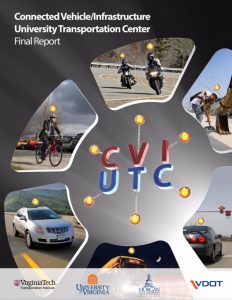

 The CVI-UTC Final Report has been released, which captures the research, education and workforce development, outreach, and technology transfer activities conducted under the CVI-UTC since inception in 2012. These activities resulted in 23 CVI applications/tools developed and tested on connected vehicle test bed facilities, over 140 publications and presentations, 33 transportation-related courses taught/year, 43 students directly supported by the grant each year, 4 degrees conferred/year to students directly funded by the CVI-UTC, over 10,000 people reached through educations/outreach efforts, and over $3.5 million dollars spent to conduct connected vehicle/infrastructure research charged with developing applications that address numerous surface transportation challenges. We invite you now to learn about the work conducted by the CVI-UTC during 2012-2016 and how this work has set the foundation upon which to build and address the transportation challenges of the future.
The CVI-UTC Final Report has been released, which captures the research, education and workforce development, outreach, and technology transfer activities conducted under the CVI-UTC since inception in 2012. These activities resulted in 23 CVI applications/tools developed and tested on connected vehicle test bed facilities, over 140 publications and presentations, 33 transportation-related courses taught/year, 43 students directly supported by the grant each year, 4 degrees conferred/year to students directly funded by the CVI-UTC, over 10,000 people reached through educations/outreach efforts, and over $3.5 million dollars spent to conduct connected vehicle/infrastructure research charged with developing applications that address numerous surface transportation challenges. We invite you now to learn about the work conducted by the CVI-UTC during 2012-2016 and how this work has set the foundation upon which to build and address the transportation challenges of the future.
The final report for Mobile User Interface Development for the Virginia Connected Corridors, submitted by Dr. Mike Mollenhauer, Alex Noble, M.S., and Dr. Zachary Doerzaph, has been released.
The purpose of this research and development activity was to build a mobile application with a low-distraction user interface appropriate for use in a connected vehicle (CV) environment. To realize their full potential, future CV applications will involve communicating information to and from drivers during vehicle operation. Mobile devices such as smart phones and tablets may be a reasonable hardware platform to provide this communication. However, there are concerns that a potential increase in driver interaction with CV applications may lead to driver distraction and possible negative impacts on driving safety. The prototype mobile device user interface that was designed and created during this project can be used to test new CV applications, validate their impact on driver safety, and inform future mobile device user interface standards for driving applications.
Click here to learn more about this project and read the final report.
The final report for Vehicle Based BSM Generator for Accelerating Deployment, submitted by Reginald Viray, Thomas Gorman, and Dr. Zac Doerzaph, has been released.
The market penetration levels needed to realize the full safety, economic, and environmental benefits of connected vehicle (CV) systems will not be met for some time. During the transition, it would be beneficial if data on non-CVs could be measured and included within the real-time CV data stream. Conceptually, a connected vehicle with advanced sensors, such as radar, could measure the dynamics of adjacent vehicles and, in addition to broadcasting its own Basic Safety Message (BSM), broadcast a pseudo BSM representing the non-connected vehicles.
This project investigated the use of radar sensors to compute the position, speed, and heading of a non-connected vehicle (non-CV) for packaging into a pseudo BSM. An algorithm was developed to estimate the speed, position, and heading of a nearby non-CV via speed, Global Positioning System (GPS) coordinates, and radar data from the CV. Field tests were conducted with two vehicles on the Virginia Smart Road and on public roads in the New River Valley of Virginia. The field tests were designed to cover a variety of vehicle formations, traffic densities, velocities, and roadway environments. The final results showed that 67.9% of the position estimates were within 3 m of the measured position along the x-axis (longitudinal) and within 1.5 m of the measured position along the y-axis (lateral). Heading and speed estimates were generally excellent. Although the estimated position accuracy was lower than desired, the data that were collected and analyzed were sufficient to suggest ways to improve the system, such as fusing the radar data with camera-based vision data or using a more accurate GPS.
Click here to learn more about this project and read the final report.
The mission statement of the Connected Vehicle/Infrastructure University Transportation Center (CVI-UTC) is to conduct research that will advance surface transportation through the application of innovative research and using connected-vehicle and infrastructure technologies to improve safety, state of good repair, economic competitiveness, livable communities, and environmental sustainability.
 Dr. Thomas A. Dingus serves as the director for the CVI-UTC, as well as the director of the Virginia Tech Transportation Institute (VTTI) and the National Surface Transportation Safety Center for Excellence (NSTSCE). Prior to joining Virginia Tech, Dr. Dingus was founding director of the National Center for Transportation Technology at the University of Idaho and was an associate director of the Center for Computer-Aided Design at the University of Iowa. Dr. Dingus has more than 220 technical publications and has managed approximately $300 million in research funding to date ($130 million as principal investigator).
Dr. Thomas A. Dingus serves as the director for the CVI-UTC, as well as the director of the Virginia Tech Transportation Institute (VTTI) and the National Surface Transportation Safety Center for Excellence (NSTSCE). Prior to joining Virginia Tech, Dr. Dingus was founding director of the National Center for Transportation Technology at the University of Idaho and was an associate director of the Center for Computer-Aided Design at the University of Iowa. Dr. Dingus has more than 220 technical publications and has managed approximately $300 million in research funding to date ($130 million as principal investigator).
